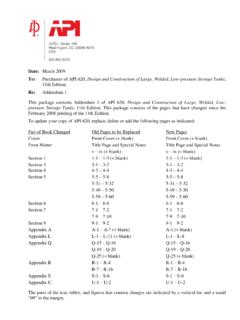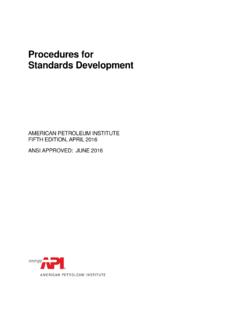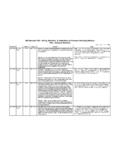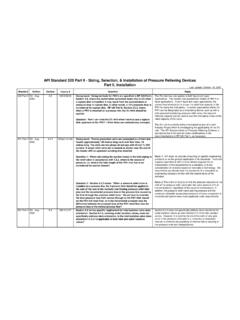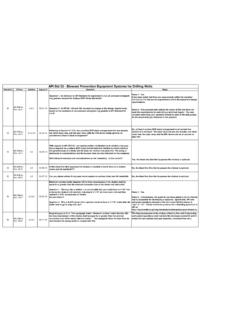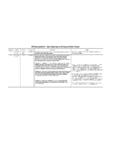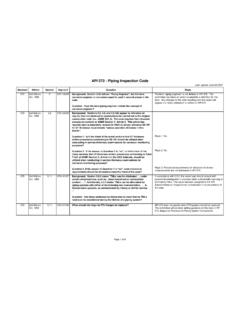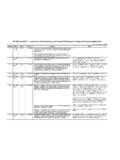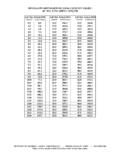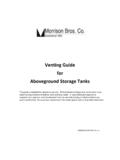Transcription of API Standard 2000 - Venting Atmospheric and Low …
1 StandardEditionSectionInquiry #QuestionReply20005th Edition - April 1998 GeneralIs there any limit for the maximum allowable linear velocity or any other parameter for the roof of a floating roof tank according to API Standard 2000 ? API Standard 2000 addresses Venting rates required for pump-in, pump-out Atmospheric breathing, and fire relief, but does not address the linear velocity of a floating roof. You also asked if there was "any other parameter" that would place a limit on the linear velocity of the roof. Of possible relevance in this regard is, once again, the pumping velocity. Depending upon the fluid type and pumping velocity, static electrical charge could build within the system. API 2000 does not address this possibility, and please consult NFPA 30 for further details in this area. 20005th Edition - April 1998 General2000-I-02/02 Which Standard do you recommend that we use for calculating the Venting requirements for a 500 liter solvent wash tank, with a MAWP of barg.
2 It is not strictly a storage tank and it is not a pressure does not have a Standard relating to Venting capacities for low-pressure process vessels. It is recommended that engineering calculations be performed based on process and Atmospheric conditions in order to determine the proper sizing of relief devices for these type vessels. However, it has been noted that may people do use API 2000 for sizing such vents, and in most cases API 2000 any error will be on the safe Edition - April 1998 General2000-I-03/00 Does the term "maximum allowable working pressure" used throughout Std 2000 equate to the design pressure, or is it a working pressure with the design pressure being another higher value?Maxumum allowable working pressure (MAWP) is determined by an engineering evaluation that takes into account safety factors as dictated by local regulations or company directives. This can be the same as the design pressure of the tank.
3 Note that API 620 refers to MAWP, whereas API 650 refers to internal design Edition - April 2 Are the values in Table 2 intended for use in sizing a vapor recovery system? No. Table 2 presents thermal vent capacities for use in sizing tank vents to prevent overpressure/underpressure and potential damage to the tank. Some of the criteria for sizing a vapor recovery system (such as the level of conservatism used in estimating the maximum Venting rates) may differ from that used in sizing relief systems. The task force believes that designing a vapor recovery system that can handle the vent capacities in Table 2 may result in excessive capacity that will rarely, if ever, be used. However, the vent size recommended in API 2000 should not be reduced for tanks equipped with vapor recovery systems. API Standard 2000 - Venting Atmospheric and Low-Pressure Storage Tanks:Nonrefrigerated and RefrigeratedLast update: April 28, 2004 Page 1 of 5 StandardEditionSectionInquiry #QuestionReplyAPI Standard 2000 - Venting Atmospheric and Low-Pressure Storage Tanks:Nonrefrigerated and RefrigeratedLast update: April 28, 2004 20005th Edition - April 1: When calculating the outbreathing Venting capacity for liquids above or below 100 degrees F, there is an equivalent given as 6 SCFH or 12 SCFH of air for each 42 US gallon barrel per hour of maximum filling rate.
4 Is this a Standard or actual barrel?Question 2: What is covered in Table 2, , is the majority of that volume dealing with hot liquids into cold liquids in the tank? What portion is for simple heating due to environment?Question 3: Std 2000 refers to these values as being appropriate for non-insulated tanks. Is there a way to calculate how insulation would effect the Venting requirements?Reply 1: We can find no reference to the terms " Standard " or "actual" being applied to liquid volume measurement. These terms are normally used for products in the vapor state where changes in timperature or pressure can cause large variations in the mass quantity of the product. This is not the case with liquids, therefore actual and Standard should be considered the 2: The thermal portions of the normal breathing requirements cover only the effects of the environment. Refer to Appendix A which discusses the basis for determining the normal Venting 3: The only credit allowed for insulation is in the environmental factors applied to the emergency Venting requirements (see , equations 1A and 1B).
5 The effects of insulation on normal Venting have not been studied by Edition - April the Venting capacity requirements stated in and , which flash point should be used in Atmospheric tanks (separation tanks) where the composition of the tank has layers, some of which have flash points above 100oF and some below 100oF?The lowest flash point fluid should be considered in vent sizing since tank vents are a relatively permanent part of the tank structure. The vents should be selected on the worse case scenario of fluids that may be introduced to the Edition - April 2 Question 1: Can the thermal Venting capacity for outbreathing obtained from Table 2 of API Standard 2000 be revised for climates that exhibit less severe temperature change than described in Appendix A? Reply 1: Yes. An engineering study of a tank at a specific location may provide the basis for a thermal vent capacity that is different from that specified in Table 2.
6 As stated in the Foreword, "Engineering studies of a particular tank may indicate that the appropriate Venting capacity for the tank is not the Venting capacity in accordance with this Standard . The many variables associated with tank Venting requirements make it impractical to set forth definite, simple rules that are applicable to all locations and conditions." 20005th Edition - April 22000-I-01/02 Does the data in Table 2B apply to insulated tanks only? If so, what type and thickness of lagging does the data apply to?These tables apply to both insulated and un-insulated tanks. No credit is given per API 2000 for insulation of tanks for the thermal breathing 2 of 5 StandardEditionSectionInquiry #QuestionReplyAPI Standard 2000 - Venting Atmospheric and Low-Pressure Storage Tanks:Nonrefrigerated and RefrigeratedLast update: April 28, 2004 20005th Edition - April 4 Referring to API Standard 2000 , Table 4, "Environmental Factors for Non-Refrigerated Aboveground Tanks," this table shows the inaccurate factor "F.
7 " Logically as the insulation thickness increases, the factor "F" should decrease. That is, the higher the insulation thickness, the lower the heat exposure and the lower the Venting requirement and not vice-versa. The corrected values as taken from the GSPA manual are enclosed herewith for reference. Incidentally, the GSPA manual itself gives reference to API for this table. The values in the left-hand column of Table 4 are not insulation thicknesses, but they are (as stated in the chart) "arbitrary insulation conductance values ..in BTU's per hour per square foot per degree F." Footnote "a" discusses these conductance values. 20005th Edition - April 4In Table 4, the "F" factor for concrete covering is generally considered to be double that for mineral insulation for a given thickness. The footnote "C" says it is to be equal to that of mineral insulation. Please verify. Footnote "C" of Table 4 instructs the user to arrive at an equivalent conductance value for the layer of concrete insulating the tank.
8 The "F" factor is found by entering the table under insulation with the equivalent conductance value. 20005th Edition - April 42000-I-04/00 Table 4A allows for reduction of required airflow rates out of the tank if the tank is insualted. Does the reduction factor also apply to an insulated tank for vacuum situation, product flow out/air flow in?Table 4A applies only to emergency Venting (fire exposure). There is no data to verify any reductions in thermal inbreathing due to Edition - April 42000-I-01/02 Table 4B, how does thermal conductance relate to thermal conductivity? If rockwool has a thermal conductivity of W/mK what is the thermal conductance ? Does thermal conductance = thermal conductivity/area?Thermal conductance is defined as the time rate of heat flow through a body. Therefore, in this case, thermal conductance = thermal Edition - April 42000-I-04/03 Background: It appears that the basis for calculating the wetted area in Std.
9 2000 , Table 3A/3B, footnote a, and RP 521, Table 4, are not consistent. In my opinion, the basis given in RP 521 is more realistic and should be use, as it accounts only for the surface area wetted by the liquid (the area contributing to vapor generation). The criteria given in Std. 2000 may result in undue over-sizing of relief systems, as here w are dealing with large surface areas (typically tanks), as compared to vessels covered in RP : Should Table 4 of RP 521 replace Table 3A/3B of Std. 2000 for calculating the wetted surface area to maintain consistency?No. The criteria from the Standard that applies to the equipment being evaluated should be used. The scope of Std. 2000 is limited to aboveground storage liquid petroleum storage tanks, and underground refrigerated storage tanks designed for operation from vacuum to 15 psig. The equations in RP 521 were reviewed by the API Subcommittee on Pressure-Relieving Systems and found to be appropriate for the equipment covered in that 3 of 5 StandardEditionSectionInquiry #QuestionReplyAPI Standard 2000 - Venting Atmospheric and Low-Pressure Storage Tanks:Nonrefrigerated and RefrigeratedLast update: April 28, 2004 20005th Edition - April 42000-I-05/03 Background: I have to calculate the emergency flow requirements for 18 storage tanks per API Std.
10 2000 in case of fire. Some of the tanks are bare metal tanks but have a cup (second wall) with the same height as the tank. Table 4A/4B provides environmental factors (F-factor) for insulated or earth covered tanks because this will absorb most incident radiations. Therefore we may multiply the calculated emergency flow requirement with this F-factor which result in a much lower capacity. Also the cups of the tanks in my application will absorb most radiations however, API 2000 does not provide a F-factor for tanks provide with this : What is the correct F-factor for tanks with the cup design ?API can only provide interpretations of requirements that pertain to the scope of the Standard . The design described is not covered in the scope of Std. 2000 , therefore, no environmental factor can be Edition - April to Section , I think there may be an error in the conversion of the fire exposure equation from English units, SCFH, into metric units, Nm3/hr.

